Jacob Nogas
Using Adaptive Experiments to Rapidly Help Students
Aug 10, 2022Abstract:Adaptive experiments can increase the chance that current students obtain better outcomes from a field experiment of an instructional intervention. In such experiments, the probability of assigning students to conditions changes while more data is being collected, so students can be assigned to interventions that are likely to perform better. Digital educational environments lower the barrier to conducting such adaptive experiments, but they are rarely applied in education. One reason might be that researchers have access to few real-world case studies that illustrate the advantages and disadvantages of these experiments in a specific context. We evaluate the effect of homework email reminders in students by conducting an adaptive experiment using the Thompson Sampling algorithm and compare it to a traditional uniform random experiment. We present this as a case study on how to conduct such experiments, and we raise a range of open questions about the conditions under which adaptive randomized experiments may be more or less useful.
Algorithms for Adaptive Experiments that Trade-off Statistical Analysis with Reward: Combining Uniform Random Assignment and Reward Maximization
Dec 21, 2021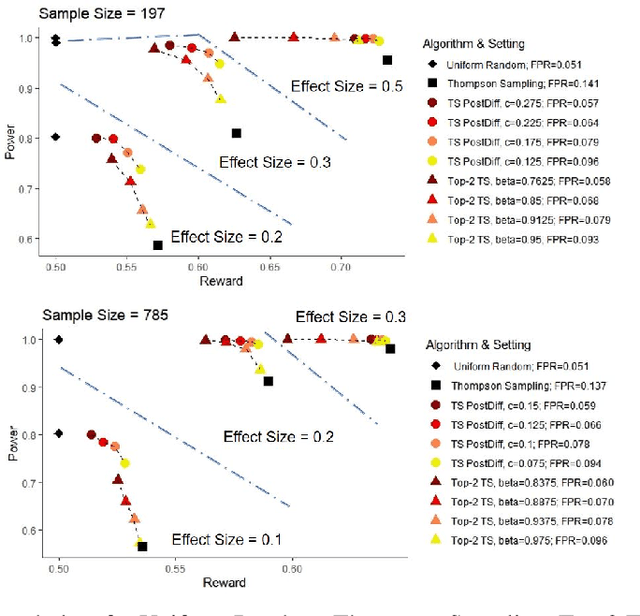
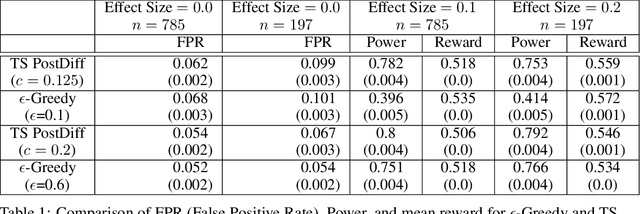
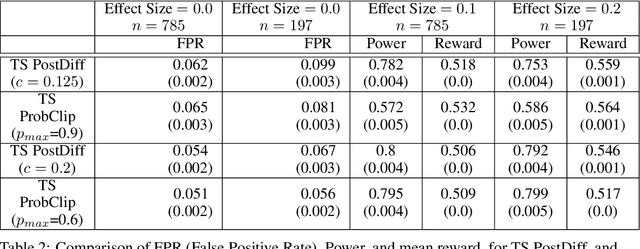
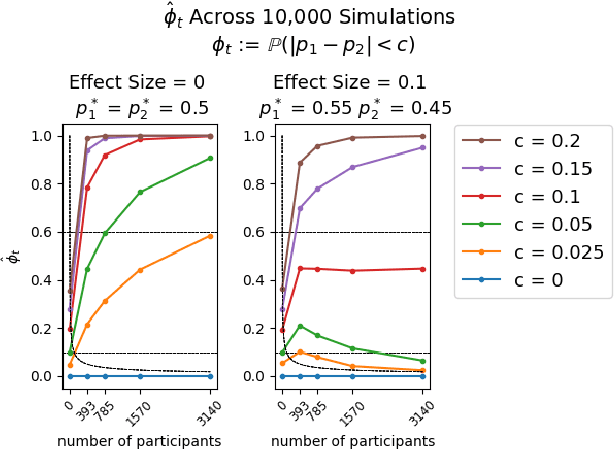
Abstract:Multi-armed bandit algorithms like Thompson Sampling can be used to conduct adaptive experiments, in which maximizing reward means that data is used to progressively assign more participants to more effective arms. Such assignment strategies increase the risk of statistical hypothesis tests identifying a difference between arms when there is not one, and failing to conclude there is a difference in arms when there truly is one. We present simulations for 2-arm experiments that explore two algorithms that combine the benefits of uniform randomization for statistical analysis, with the benefits of reward maximization achieved by Thompson Sampling (TS). First, Top-Two Thompson Sampling adds a fixed amount of uniform random allocation (UR) spread evenly over time. Second, a novel heuristic algorithm, called TS PostDiff (Posterior Probability of Difference). TS PostDiff takes a Bayesian approach to mixing TS and UR: the probability a participant is assigned using UR allocation is the posterior probability that the difference between two arms is `small' (below a certain threshold), allowing for more UR exploration when there is little or no reward to be gained. We find that TS PostDiff method performs well across multiple effect sizes, and thus does not require tuning based on a guess for the true effect size.
Challenges in Statistical Analysis of Data Collected by a Bandit Algorithm: An Empirical Exploration in Applications to Adaptively Randomized Experiments
Mar 26, 2021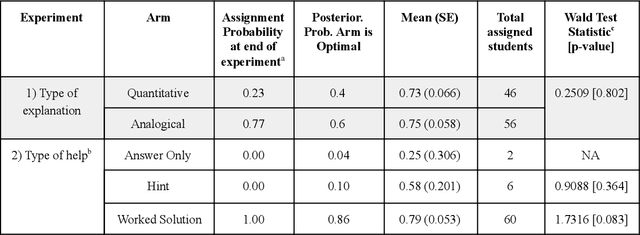

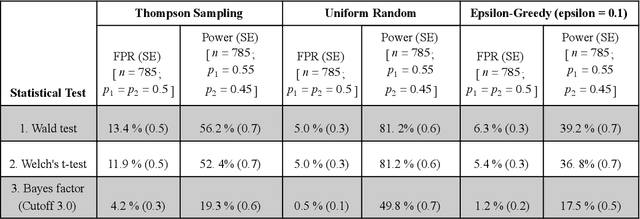
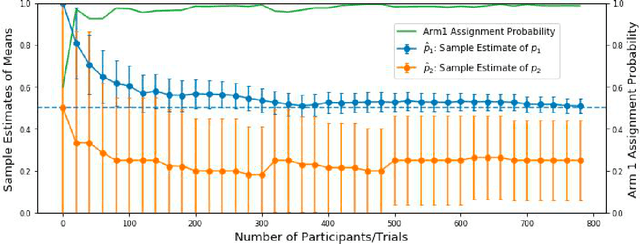
Abstract:Multi-armed bandit algorithms have been argued for decades as useful for adaptively randomized experiments. In such experiments, an algorithm varies which arms (e.g. alternative interventions to help students learn) are assigned to participants, with the goal of assigning higher-reward arms to as many participants as possible. We applied the bandit algorithm Thompson Sampling (TS) to run adaptive experiments in three university classes. Instructors saw great value in trying to rapidly use data to give their students in the experiments better arms (e.g. better explanations of a concept). Our deployment, however, illustrated a major barrier for scientists and practitioners to use such adaptive experiments: a lack of quantifiable insight into how much statistical analysis of specific real-world experiments is impacted (Pallmann et al, 2018; FDA, 2019), compared to traditional uniform random assignment. We therefore use our case study of the ubiquitous two-arm binary reward setting to empirically investigate the impact of using Thompson Sampling instead of uniform random assignment. In this setting, using common statistical hypothesis tests, we show that collecting data with TS can as much as double the False Positive Rate (FPR; incorrectly reporting differences when none exist) and the False Negative Rate (FNR; failing to report differences when they exist)...
Spatio-Temporal Adversarial Learning for Detecting Unseen Falls
May 19, 2019



Abstract:Fall detection is an important problem from both the health and machine learning perspective. A fall can lead to severe injuries, long term impairments or even death in some cases. In terms of machine learning, it presents a severely class imbalance problem with very few or no training data for falls owing to the fact that falls occur rarely. In this paper, we take an alternate philosophy to detect falls in the absence of their training data, by training the classifier on only the normal activities (that are available in abundance) and identifying a fall as an anomaly. To realize such a classifier, we use an adversarial learning framework, which comprises of a spatio-temporal autoencoder for reconstructing input video frames and a spatio-temporal convolution network to discriminate them against original video frames. 3D convolutions are used to learn spatial and temporal features from the input video frames. The adversarial learning of the spatio-temporal autoencoder will enable reconstructing the normal activities of daily living efficiently; thus, rendering detecting unseen falls plausible within this framework. We tested the performance of the proposed framework on camera sensing modalities that may preserve an individual's privacy (fully or partially), such as thermal and depth camera. Our results on three publicly available datasets show that the proposed spatio-temporal adversarial framework performed better than other frame based (or spatial) adversarial learning methods.
DeepFall -- Non-invasive Fall Detection with Deep Spatio-Temporal Convolutional Autoencoders
Sep 13, 2018



Abstract:Human falls rarely occur; however, detecting falls is very important from the health and safety perspective. Due to the rarity of falls, it is difficult to employ supervised classification techniques to detect them. Moreover, in these highly skewed situations it is also difficult to extract domain specific features to identify falls. In this paper, we present a novel framework, \textit{DeepFall}, which formulates the fall detection problem as an anomaly detection problem. The \textit{DeepFall} framework presents the novel use of deep spatio-temporal convolutional autoencoders to learn spatial and temporal features from normal activities using non-invasive sensing modalities. We also present a new anomaly scoring method that combines the reconstruction score of frames across a video sequences to detect unseen falls. We tested the \textit{DeepFall} framework on three publicly available datasets collected through non-invasive sensing modalities, thermal camera and depth cameras and show superior results in comparison to traditional autoencoder and convolutional autoencoder methods to identify unseen falls.
 Add to Chrome
Add to Chrome Add to Firefox
Add to Firefox Add to Edge
Add to Edge